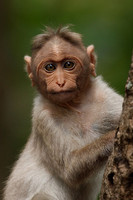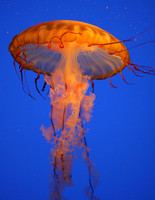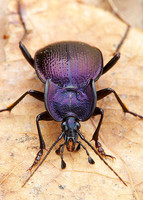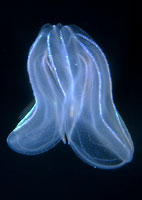Animals
Metazoa



This tree diagram shows the relationships between several groups of organisms.
The root of the current tree connects the organisms featured in this tree to their containing group and the rest of the Tree of Life. The basal branching point in the tree represents the ancestor of the other groups in the tree. This ancestor diversified over time into several descendent subgroups, which are represented as internal nodes and terminal taxa to the right.

You can click on the root to travel down the Tree of Life all the way to the root of all Life, and you can click on the names of descendent subgroups to travel up the Tree of Life all the way to individual species.
For more information on ToL tree formatting, please see Interpreting the Tree or Classification. To learn more about phylogenetic trees, please visit our Phylogenetic Biology pages.
close boxReferences
Adoutte, A., G. Balavoine, N. Lartillot, O. Lespinet, B. Prud'homme, and R. de Rosa. 2000. The new animal phylogeny: Reliability and implications. Proceedings of the National Academy of Sciences (USA) 97:4453-4456.
Anderson, C. L. 1998. Phylogenetic relationships of the Myxozoa. Pages 341-350 in Evolutionary Relationships among Protozoa (G.H. Coombs, K. Vickerman, M.A. Sleigh, and A. Warren, eds.) Chapman & Hall, London.
Anderson, C. L., E. U. Canning, and B. Okamura. 1998. A triploblast origin for Myxozoa? Nature 392:346-347.
Ayala, F. J., A. Rzhetsky, and F. J. Ayala. 1998. Origin of the metazoan phyla: Molecular clocks confirm paleontological estimates. PProceedings of the National Academy of Sciences (USA) 95:606-611.
Baguñà, J., P. Martinez, J. Paps, and M. Riutort. 2008. Back in time: a new systematic proposal for the Bilateria. Philosophical Transactions of the Royal Society Series B 363(1496):1481-1491
Borchiellini, C., M. Manuel, E. Alivon, N. Boury-Esnault, J. Vacelet, and Y. Le Parco. 2001. Sponge paraphyly and the origin of Metazoa. Journal of Evolutionary Biology 14:171-179.
Briggs, D. E. G., D. H. Erwin, and F. J. Collier. 1994. The Fossils of the Burgess Shale. Smithsonian Institution Press, Washingthon, D.C.
Brusca, R. C. and G. J. Brusca. 2002. Invertebrates. Second Edition. Sinauer Associates, Inc., Sunderland, Massachusetts.
Budd, G. E. 2008. The earliest fossil record of the animals and its significance. Philosophical Transactions of the Royal Society Series B 363(1496):1425-1434.
Carroll, S. B., J. K. Grenier, and S. D. Weatherbee. 2001. From DNA to Diversity. Molecular Genetics and the Evolution of Animal Design. Blackwell Science, Malden, Massachusetts.
Cavalier-Smith, T., M. T. E. P. Allsopp, E. E. Chao, N. Boury-Esnault, and J. Vacelet. 1996. Sponge phylogeny, animal monophyly, and the origin of the nervous system: 18S rRNA evidence. Canadian Journal of Zoology 74:2031-2045.
Chen, J.-Y., P. Oliveri, C.-W. Li, G.-Q. Zhou, F. Gao, J. W. Hagadorn, K. J. Peterson, and E. H. Davidson. 2000. Precambrian animal diversity: Putative phosphatized embryos from the Doushantuo Formation of China. Proceedings of the National Academy of Sciences (U.S.A.) 97:4457-4462.
Collins, A. G. 1998. Evaluating multiple alternative hypotheses for the origin of Bilateria: An analysis of 18S rRNA molecular evidence. Proceedings of the National Academy of Sciences (U.S.A.) 95:15458-15463.
Collins, A. G. and J. W. Valentine. 2001. Defining phyla: evolutionary pathways to metazoan body plans. Evolution & Development 3:432-442.
Conway Morris, S. 1993. The fossil record and the early evolution of the Metazoa. Nature 361:219-225.
Conway Morris, S. 1998. The Crucible of Creation: The Burgess Shale and the Rise of Animals. Oxford University Press, Oxford, UK.
Copley, R. R. 2008. The animal in the genome: comparative genomics and evolution. Philosophical Transactions of the Royal Society Series B 363(1496):1453-1461.
Dellaporta, S. L., A. Xu, S. Sagasser, W. Jakob, M. A. Moreno, L. W. Buss, and B. Schierwater. 2006. Mitochondrial genome of Trichoplax adhaerens supports placozoa as the basal lower metazoan phylum. Proceedings of the National Academy of Sciences (U.S.A.) 103(23):8751-8756.
Dewel, R. A. 2000. Colonial origin for Eumetazoa: Major morphological transitions and the origin of Bilaterian complexity. Journal of Morphology 243:35-74.
Dunn, C. W., A Hejnol, D. Q. Matus, K. Pang, W. E. Browne, S. A. Smith, E. Seaver, G. W. Rouse, M. Obst, G. D. Edgecombe, M. V. Sørensen, S. H. D. Haddock, A. Schmidt-Rhaesa, A. Okusu, R. M. Kristensen, W. C. Wheeler, M. Q. Martindale, and G. Giribet. 2008. Broad phylogenomic sampling improves resolution of the animal tree of life. Nature. doi:10.1038/nature06614
Eernisse, D. J. and K. J. Peterson. 2004. The history of animals. Pages 197-208 in Assembling the Tree of Life, J. Cracraft and M. J. Donoghue, eds. Oxford University Press, New York.
Ender, A. and B. Schierwater. 2003. Placozoa are not derived cnidarians: Evidence from molecular morphology. Molecular Biology and Evolution 20(1):130-134.
Erwin, D. H. 1993. The origin of metazoan development: A palaeobiological perspective. Biological Journal of the Linnean Society 50: 255-274.
Ferrier, D. E. K. and P. W. H. Holland. 2001. Ancient origin of the Hox gene cluster. Nature Reviews Genetics 2:33-38.
Finnerty, J. R., K. Pang, P. Burton, D. Paulson, and M. Q. Martindale. 2004. Origins of bilateral symmetry; Hox and dpp expression in a sea anemone. Science 304:1335-37.
Giribet, G. 2002. Current advances in the phylogenetic reconstruction of metazoan evolution. A new paradigm for the Cambrian explosion? Molecular Phylogenetics and Evolution 24:345-357.
Giribet, G., C. W. Dunn, G. D. Edgecombe, and G. W. Rouse. 2007. A modern look at the Animal Tree of Life. Pages 61-79 in: Zhang, Z.-Q. & Shear, W.A., eds. Linnaeus Tercentenary: Progress in Invertebrate Taxonomy. Zootaxa 1668:1-766.
Gould, S. J. 1989. Wonderful Life: The Burgess Shale and the Nature of History. Norton, New York.
Haen, K. M., B. F. Lang, S. A. Pomponi, and D. V. Lavrov. 2007. Glass sponges and bilaterian animals share derived mitochondrial genomic features: a common ancestry or parallel evolution? Molecular Biology and Evolution 24(7):1518 - 1527.
Halanych, K. 2004. The new view of animal phylogeny. Annual Review of Ecology, Evolution, and Systematics 35:229-256.
Hanelt B., D. VanSchyndel, C. M. Adema, L. A. Lewis, E. S. Loker. 1996. The phylogenetic position of Rhopalura ophiocomae (Orthonectida) based on 18S ribosomal DNA sequence analysis. Molecular Biology and Evolution 13:1187-1191.
Jenner, R. A. 2004. The scientific status of metazoan cladistics: why current research practice must change. Zoologica Scripta 33(4):293-310.
Jenner, R. A. 2004. When molecules and morphology clash: Reconciling conflicting phylogenies of the Metazoa by considering secondary character loss. Evolution & Development 6(5):372-378.
Jenner, R. A. and D. T. J. Littlewood. 2008. Problematica old and new. Philosophical Transactions of the Royal Society Series B 363(1496):1503-1512.
Jenner, R. A. and F. R. Schram. 1999. The grand game of metazoan phylogeny: rules and strategies. Biological Reviews 74:121-142.
Jiménez-Guri, E., H. Philippe, B. Okamura, P. W. H. Holland. 2007. Buddenbrockia is a cnidarian worm. Science 317(5834):116-118.
Kamm, K., B. Schierwater, W. Jakob, S. L. Dellaporta, and D. J. Miller. 2006. Axial patterning and diversification in the Cnidaria predate the Hox system. Current Biology 16:920-926.
Kim, J., W. Kim, and C. W. Cunningham. 1999. A new perspective on lower metazoan relationships from 18S rDNA sequences. Molecular Biology and Evolution 16:423-427.
Knoll, A. H. and S. B. Carroll. 1999. Early animal evolution: emerging views from comparative biology and geology. Science 284:2129-2137.
Kruse, M., S. P. Leys, I. M. Mueller, and W. E. G. Mueller. 1998. Phylogenetic position of the hexactinellida within the phylum porifera based on the amino acid sequence of the protein kinase C from Rhabdocalyptus dawsoni. Journal of Molecular Evolution 46:721-728.
Levin, H. L. 1999. Ancient Invertebrates and Their Living Relatives. Prentics Hall, Upper Saddle River, New Jersey.
Martindale, M. Q., J. R. Finnerty, and J. Q. Henry. 2002. The Radiata and the evolutionary origins of the bilaterian body plan. Molecular Phylogenetics and Evolution 24:358-365.
Matus, D. Q., K. Pang, H. Marlow, C. W. Dunn, G. H. Thomsen, and M. Q. Martindale. 2006. Molecular evidence for deep evolutionary roots of bilaterality in animal development. Proceedings of the National Academy of Sciences (USA) 103(30):11195-11200.
Medina, M., A. G. Collins, J. D. Silberman, and M. L. Sogin. 2001. Evaluating hypotheses of basal animal phylogeny using complete sequences of large and small subunit rRNA. Proceedings of the National Academy of Sciences (U.S.A.) 98:9707-9712.
Minelli, A. 2007. Invertebrate taxonomy and evolutionary developmental biology. Pages 55-60 in: Zhang, Z.-Q. & Shear, W.A., eds. Linnaeus Tercentenary: Progress in Invertebrate Taxonomy. Zootaxa 1668:1-766.
Monteiro, A. S., B. Okamura, and P. W. H. Holland. 2002. Orphan worm finds a home: Buddenbrockia is a Myxozoan. Molecular Biology and Evolution 19:968-971.
Nielsen, C. 2001. Animal Evolution: Interrelationships of the Living Phyla. Second Edition. Oxford University Press, Oxford.
Nielsen, C., N. Scharff, and D. Eibye-Jacobsen. 1996. Cladistic analyses of the animal kingdom. Biological Journal of the Linnean Society 57:385-410.
Okamura, B., A. Curry, T. S. Wood, and E. U. Canning. 2002. Ultrastructure of Buddenbrockia identifies it as a myxozoan and verifies the bilaterian origin of the Myxozoa. Parasitology 124:215-223.
Peterson, K. J. and N. J. Butterfield. 2005. Origin of the Eumetazoa: Testing ecological predictions of molecular clocks against the Proterozoic fossil record. Proceedings of the National Academy of Sciences (USA) 102(27):9547-9552.
Peterson, K. J., J. A. Cotton, J. G. Gehling and D. Pisani. 2008. The Ediacaran emergence of bilaterians: congruence between the genetic and the geological fossil records. Philosophical Transactions of the Royal Society Series B 363(1496):1435-1443.
Peterson, K. J. and E. H. Davidson. 2000. Regulatory evolution and the origin of bilaterians. Proceedings of the National Academy of Sciences (U.S.A.) 97:4430-4433.
Peterson, K. J. and D. J. Eernisse. 2001. Animal phylogeny and the ancestry of bilaterians: inferences from morphology and 18S rDNA gene sequences. Evolution & Development 3:170-205.
Peterson, K. J., J. B. Lyons, K. S. Nowak, C. M. Takacs, M. J. Wargo and M. A. McPeek. 2004. Estimating metazoan divergence times with a molecular clock. Proceedings of the National Academy of Sciences (USA) 101(17):6536-6541.
Philippe, H. and M. J. Telford. 2006. Large-scale sequencing and the new animal phylogeny. Trends in Ecology & Evolution 21(11):614-620.
Putnam, N. H., M. Srivastava, U. Hellsten, B. Dirks, J. Chapman, A. Salamov, A. Terry, H. Shapiro, E. Lindquist, V. V. Kapitonov, J. Jurka, G. Genikhovich, I. V. Grigoriev, S. M. Lucas, R. E. Steele, J. R. Finnerty, U. Technau, M. Q. Martindale, and D. S. Rokhsar. 2007. Sea anemone genome reveals ancestral eumetazoan gene repertoire and genomic organization. Science 317(5834):86-94.
Ruiz-Trillo, I., A. J. Roger, G. Burger, M. W. Gray, and B. F. Lang. 2008. A phylogenomic investigation into the origin of Metazoa. Molecular Biology and Evolution 25:664-672.
Ruppert, E. E., R. S. Fox, and R. D. Barnes. 2004. Invertebrate Zoology, a Functional Evolutionary Approach. 7th ed. Brooks/Cole-Thomson Learn, Belmont, CA.
Schierwater, B., M. Eitel, W. Jakob, H.-J. Osigus, H. Hadrys, S. L. Dellaporta, S.-O. Kolokotronis, and R. DeSalle. 2009. Concatenated molecular and morphological analysis sheds light on early metazoan evolution and fuels a modern “Urmetazoon” hypothesis. PLoS Biol 7(1): e1000020. doi:10.1371/journal.pbio.1000020.
Schlegel, M., J. Lom, A. Stechmann, D. Bernhard, D. Leipe, I. Dykova, and M. L. Sogin. 1996. Phylogenetic analysis of complete small subunit ribosomal RNA coding region of Myxidium lieberkuehni: Evidence that Myxozoa are Metazoa and related to the Bilateria. Archiv für Protistenkunde 147:1-9.
Siddall, M. E., D. S. Martin, D. Bridge, S. S. Desser, and D. K. Cone. 1995. The demise of a phylum of protists: Phylogeny of myxozoa and other parasitic cnidaria. Journal of Parasitology 81:961-967.
Siddall, M. E. and M. F. Whiting. 1999. Long-branch abstractions. Cladistics 15:9-24.
Smothers, J. F., C. D. von Dohlen, L. H. Smith, Jr., and R. D. Spall. 1994. Molecular evidence that the myxozoan protists are metazoans. Science 265:1719-1721.
Valentine, J. W., D. Jablonski, D. H. Erwin. 1999. Fossils, molecules and embryos: new perspectives on the Cambrian explosion. Development 126:851-859.
Wainright, P.O., G. Hinkle, M.L. Sogin, and S.K. Stickel. 1993. Monophyletic origins of the Metazoa: an evolutionary link with Fungi. Science 260: 340-342.
Wallberg, A., M. Thollesson, J. S. Farris, and U. Jondelius. 2004. The phylogenetic position of the comb jellies (Ctenophora) and the importance of taxonomic sampling. Cladistics 20(6):558-578.
Wang, D. Y.-C., S. Kumar, and S. B. Hedges. 1999. Divergence time estimates for the early history of animal phyla and the origin of plants, animals, and fungi. Proceedings of the Royal Society London Series B 266:163-171.
Zrzavy, J. 2001. The interrelationships of metazoan parasites: a review of phylum- and higher-level hypotheses from recent morphological and molecular phylogenetic analyses. Folia Parasitologica 48:81-103.
Zrzavy, J. and V. Hypsa. 2003. Myxozoa, Polypodium, and the origin of the Bilateria: The phylogenetic position of "Endocnidozoa" in light of the rediscovery of Buddenbrockia. Cladistics 19(2):164-169.
Zrzavy, J., S. Mihulka, P. Kepka, A. Bezdek, and D. Tietz. 1998. Phylogeny of the Metazoa based on morphological and 18S ribosomal DNA evidence. Cladistics 14:249-285.
Information on the Internet
- Introduction to the Metazoa Animals, Animals, Animals!. University of California Museum of Paleontology.
- Animal Diversity Web. University of Michigan Museum of Zoology.
- BiologyBrowser: Invertebrata.
- The Shape of Life. Companion website to the PBS television series that reveals the dramatic rise of the animal kingdom through the breakthroughs of scientific discovery.
- The Origin of Animal Body Plans. 1997 American Scientist article by Douglas Erwin, James Valentine and David Jablonski.
- Animal Kingdom Gets a New Root. Wired Science, January 2009.
- New Tree Of Life Divides All Lower Metazoans From Higher Animals, Molecular Research Confirms. Science Daily, January 2009.
- The First Animal On Earth Was Significantly More Complex Than Previously Believed. Science Daily, April 2008.
- Tree Of Animal Life Has Branches Rearranged, By Evolutionary Biologists. Science Daily, March 2008.
- When we were worms. Report on research in early bilaterian evolution. BBC News.
- The Homeobox Page. Thomas R. Bürglin's page about the homeobox genes which play important roles in the development of multicellular organisms.
- A brief overview of Hox genes. Pharyngula.
- Marine Invertebrate Larvae: A Study in Morphological Diversity. University of Saskatchewan Archive of Dr. Thorston Lacalli.
- Introduction to Ichnology: The Study of Plant and Animal Traces. Emory University.
- The Wandtafeln of Rudolph Leuckart (1822-1898). Marine Biological Laboratory Woods Hole.
Metazoa in Special Habitats
- Marine Organisms at the MBL. Marine Biological Laboratory Woods Hole.
- Coral Reef Information System (CoRIS). National Oceanic and Atmospheric Administration, U.S. Department of Commerce.
- SeamountsOnline. NSF-funded project designed to gather information on species found in seamount habitats. San Diego Supercomputer and Scripps Institute of Oceanography.
- Voyage to the Deep. University of Delaware College of Marine Studies and Sea Grant College Program.
- International Association of Meiobenthologists (IAM).
- Anchialine Caves and Cave Fauna of the World. Thomas M. Iliffe, Texas A&M University at Galveston.
- Groundwater Biology Home Page. Giuseppe L. Pesce.
Fossil Metazoa
- The Dawn of Animal Life. Miller Museum Online Exhibit.
- Invertebrate Paleontology. Peabody Museum of Natural History, Yale University.
- Life of the Vendian. University of California Museum of Paleontology.
- The Burgess Shale : A Hidden Treasure In The Canadian Rockies. Hooper Virtual Paleontological Museum.
- Burgess Shale fossils. Andrew MacRae.
- Mazon Creek Fossils. Illinois State Museum.
Title Illustrations

| Scientific Name | Macaca radiata |
|---|---|
| Location | B R Hills,Karnataka, INDIA |
| Specimen Condition | Live Specimen |
| Source | Curious Look |
| Source Collection | Flickr |
| Image Use |
 This media file is licensed under the Creative Commons Attribution-NonCommercial-NoDerivs License - Version 2.0. This media file is licensed under the Creative Commons Attribution-NonCommercial-NoDerivs License - Version 2.0.
|
| Copyright | © 2008 Supriya 'n' Subharghya |
| Scientific Name | Chrysaora fuscescens |
|---|---|
| Location | Ripley Aquarium, Myrtle Beach, South Carolina, USA--native to Pacific Coast |
| Comments | Class: Scyphozoa, Order: Semaeostomeae, Family: Pelagiidae Common name: Sea Nettle, or Pacific Sea Nettle |
| Specimen Condition | Live Specimen |
| Identified By | Ripley Aquarium, Myrtle Beach, South Carolina |
| Behavior | Captive specimen |
| Life Cycle Stage | medusa |
| View | lateral |
| Size | bell circa 10 cm diameter |
| Image Use |
 This media file is licensed under the Creative Commons Attribution-NonCommercial License - Version 2.5. This media file is licensed under the Creative Commons Attribution-NonCommercial License - Version 2.5.
|
| Copyright |
© 2007 Patrick Coin

|
| Scientific Name | Scaphinotus petersi |
|---|---|
| Location | USA AZ Yavapai County |
| Source | Scaphinotus petersi - ground beetle |
| Copyright |
© Alex Wild

|
| Location | captive at Texas State Aquarium |
|---|---|
| Specimen Condition | Live Specimen |
| Copyright |
© Greg and Marybeth Dimijian

|
| Scientific Name | Haliclona |
|---|---|
| Creator | David Remsen |
| Copyright |
© 1995 Marine Biological Laboratory, Woods Hole

|
About This Page
Page copyright © 2002
 Page: Tree of Life
Animals. Metazoa.
The TEXT of this page is licensed under the
Creative Commons Attribution-NonCommercial License - Version 3.0. Note that images and other media
featured on this page are each governed by their own license, and they may or may not be available
for reuse. Click on an image or a media link to access the media data window, which provides the
relevant licensing information. For the general terms and conditions of ToL material reuse and
redistribution, please see the Tree of Life Copyright
Policies.
Page: Tree of Life
Animals. Metazoa.
The TEXT of this page is licensed under the
Creative Commons Attribution-NonCommercial License - Version 3.0. Note that images and other media
featured on this page are each governed by their own license, and they may or may not be available
for reuse. Click on an image or a media link to access the media data window, which provides the
relevant licensing information. For the general terms and conditions of ToL material reuse and
redistribution, please see the Tree of Life Copyright
Policies.
Citing this page:
Tree of Life Web Project. 2002. Animals. Metazoa. Version 01 January 2002 (temporary). http://tolweb.org/Animals/2374/2002.01.01 in The Tree of Life Web Project, http://tolweb.org/















 Go to quick links
Go to quick search
Go to navigation for this section of the ToL site
Go to detailed links for the ToL site
Go to quick links
Go to quick search
Go to navigation for this section of the ToL site
Go to detailed links for the ToL site